Key takeaways:
- Album packaging enhances the listener’s experience, creating a personal connection between the music and the artist through design and materials.
- Effective packaging elements, such as texture, typography, and additional materials, can elevate an album from ordinary to memorable.
- Visual art plays a crucial role in shaping perceptions and evoking emotions tied to the music, often triggering nostalgia and personal memories.
- Sustainability in packaging is increasingly important, reflecting the values of artists and resonating with environmentally conscious audiences.
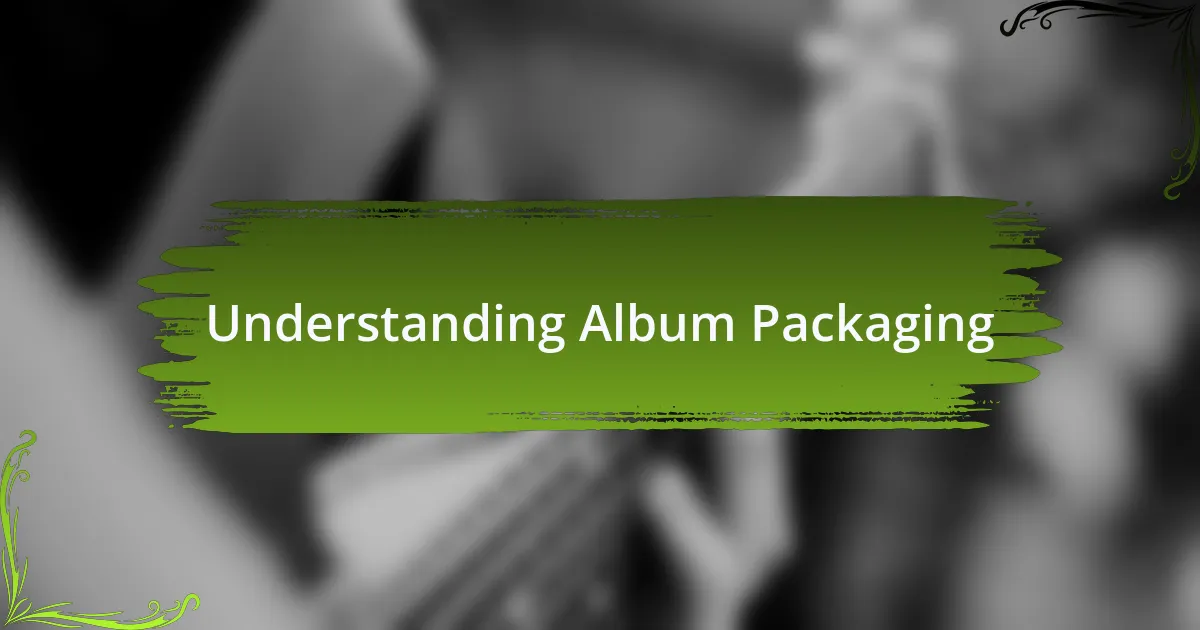
Understanding Album Packaging
Album packaging is more than just a vessel for music; it’s an experience that bridges the listener and the artist. I remember the first time I held a beautifully crafted vinyl record, complete with artwork that told a story on its own. The weight of it in my hands added a sensory component that digital music simply can’t replicate.
Have you ever stopped to consider how packaging can impact your perception of an album? For me, the glossy finishes or textured covers not only enhance the aesthetic appeal but also evoke emotions linked to the music within. I often find myself drawn to albums that feature unique designs; they bring a sense of intimacy and connection, making the music feel more personal.
The choice of materials, from eco-friendly paper to gatefold designs, reveals a lot about an artist’s vision and values. I recall unboxing a special edition album and being struck by the care put into every detail, from the color palette to the font choice. It made me ponder: how much do these elements influence our appreciation of the music itself?
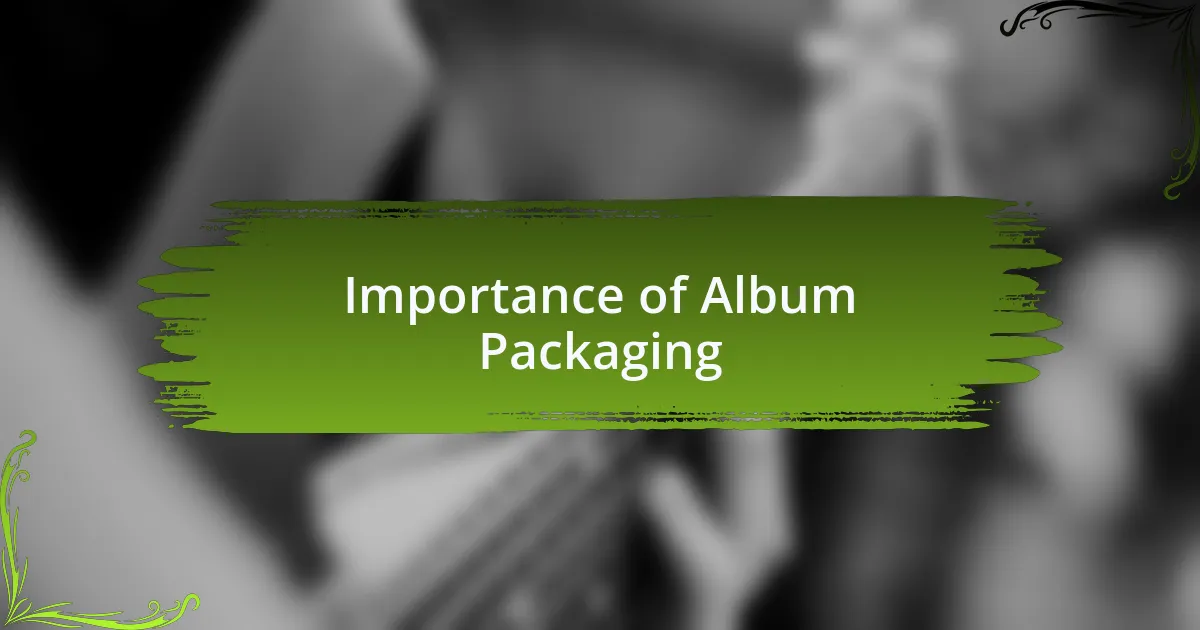
Importance of Album Packaging
Album packaging plays a crucial role in shaping the listener’s experience and perception of the music. I still vividly remember unwrapping a limited edition CD that came with a detailed booklet. Each page was filled with handwritten lyrics and photos that felt like a personal conversation with the artist. That tangible connection made the music resonate on a deeper level, almost like I was part of the creative process.
Consider how packaging can serve as a visual representation of an artist’s identity. I once encountered an album with vibrant, thought-provoking artwork that complemented the sound so perfectly, it felt like the images were an extension of the music itself. Does the cover art influence how we interpret the songs? In my experience, a captivating design often leads me to discover layers in the music I might not have caught otherwise.
Additionally, the physicality of an album can evoke nostalgia, reminding us of the moments we associate with that music. When I encounter an album I loved as a teenager, the heft of the case in my hand brings back memories of late-night listening sessions. In a world increasingly dominated by digital downloads, these unique, thoughtfully designed packages serve as a cherished reminder of the tangible connection we have to the artists we admire.
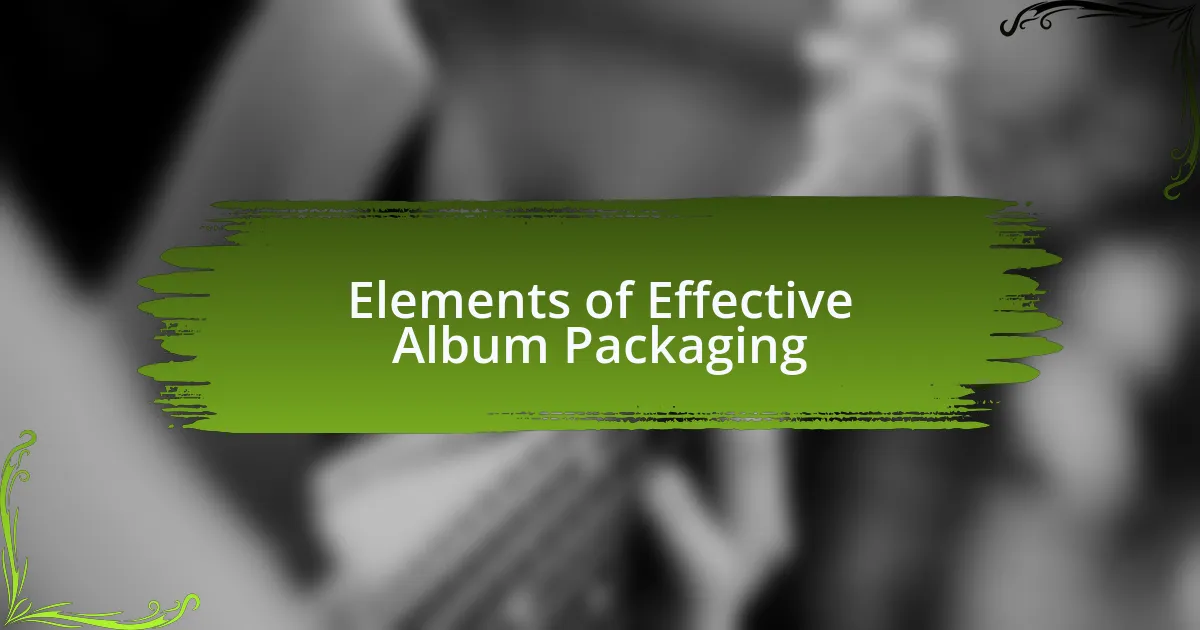
Elements of Effective Album Packaging
When I think about effective album packaging, the first thing that comes to mind is the impact of texture. I remember picking up a vinyl record that had a matte finish, making it feel almost like a piece of art. That tactile experience transformed the act of simply listening into an immersive ritual where I felt connected to the music on a whole new level. Isn’t it fascinating how something as simple as the feel of the cover can deepen our appreciation for the album?
Typography is another critical element that often goes overlooked. I once stumbled upon an album with bold, hand-lettered fonts that matched the raw energy of the music. It drew me in instantly, almost like a beckoning voice from the cover itself. In my opinion, the typeface can capture the essence of the album and set expectations for what’s inside, creating an anticipatory buzz that enhances the listening experience.
Finally, the inclusion of extra materials can elevate an album from good to memorable. I recall unboxing an album that came with a mini poster and a personal note from the artist. Those little surprises felt like gifts, enhancing my connection to the music. How often does an album become a keepsake because of these thoughtful additions? In my experience, the right extras can turn a simple album into a beloved treasure that we cherish for years to come.
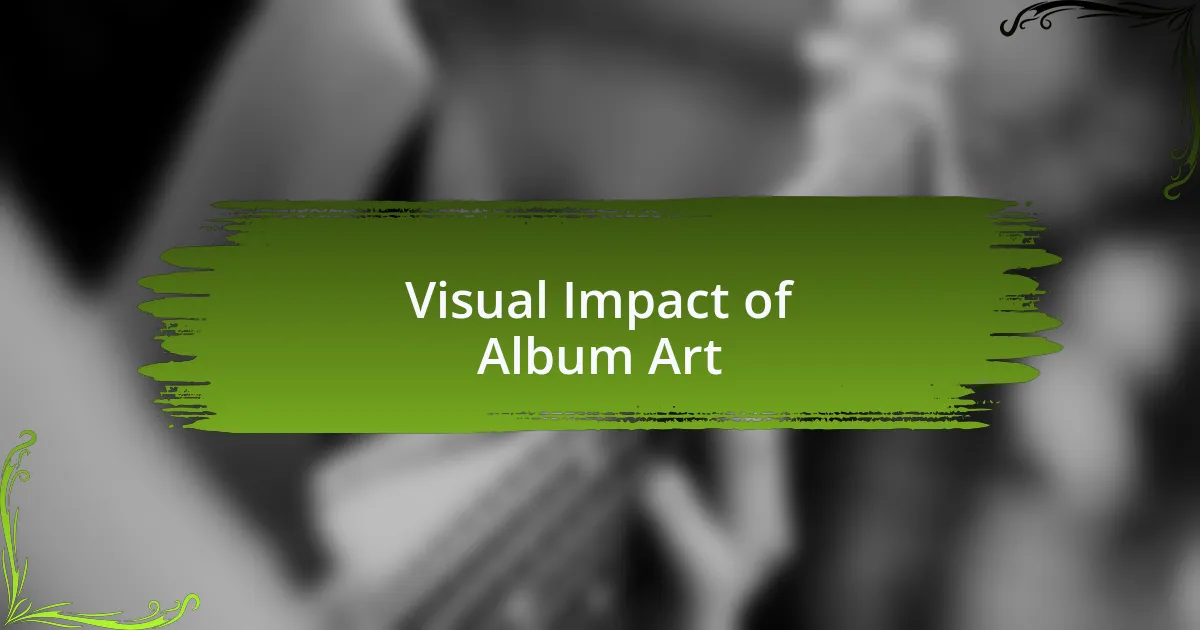
Visual Impact of Album Art
The visual impact of album art is something I truly appreciate. I recall a time when I came across an indie band’s album with striking, surreal imagery. The cover was so mesmerizing that I found myself staring at it for minutes, pondering the themes that would unfold within the tracks. Isn’t it amazing how a single image can evoke curiosity and set the stage for the musical journey ahead?
There’s also a powerful connection between the art and the music itself. I remember when I first encountered a classic rock album with vibrant colors and dynamic shapes that perfectly matched the energetic beats inside. That alignment of visuals and audio made for a cohesive experience that lingered in my mind long after the last note faded away. How often do we find ourselves choosing an album solely based on its visuals, driven by an instinct that the music inside might resonate with us?
Album art can carry nostalgia and emotion that ties directly to personal memories. I recently revisited an album from my teenage years, and its cover instantly transported me back to countless summer nights with friends, blasting music under the stars. That image wasn’t just a design; it was a capsule of my past, reminding me of moments that shaped who I am today. Isn’t that the real power of album art? It holds the potential to weave stories that go beyond the music, connecting us to our own experiences.
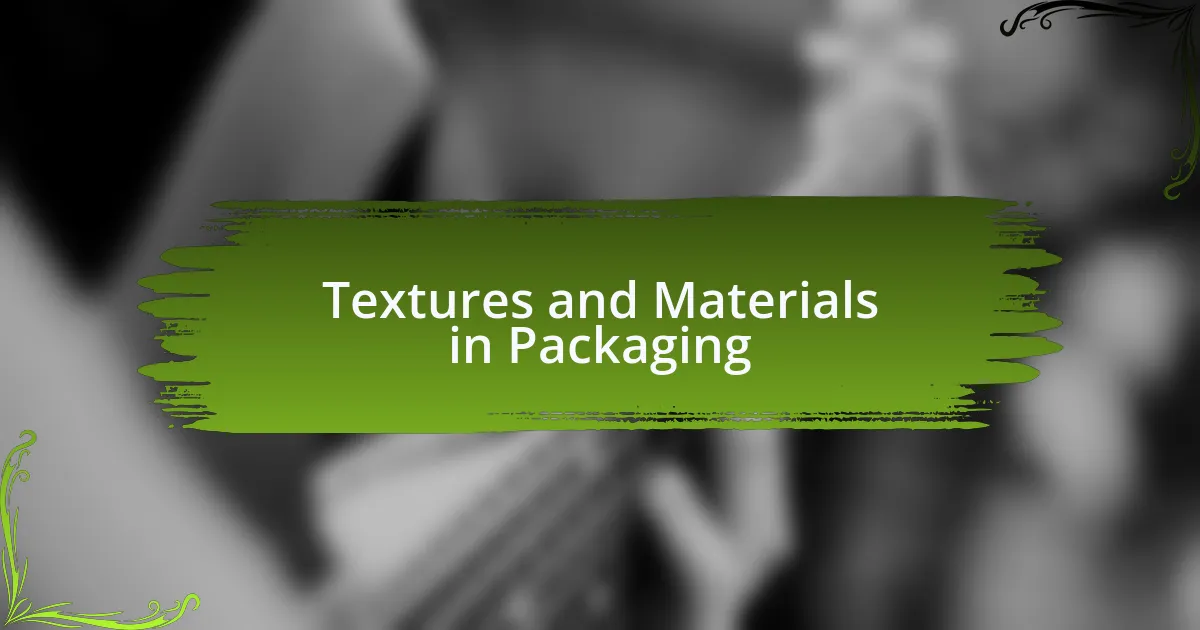
Textures and Materials in Packaging
When it comes to textures and materials in album packaging, I find myself drawn to how these elements create a tactile experience that enhances the overall appeal. I still remember the sensation of opening a vinyl record sleeve made of thick, textured cardboard. The weight and grain of the material made the entire experience feel significant, as if I were unearthing a treasured artifact rather than just another album. Doesn’t it feel rewarding to interact with something that feels luxurious in your hands?
Then there’s the use of unique finishes like matte or gloss lamination. I once encountered an album with a soft-touch finish that made it feel almost like fabric. It caught my attention not only because it separated itself from more traditional packaging but also because it felt intimate, as though the artist was inviting me to share a more personal connection. How does it change our perception of the music when the physical packaging feels so thoughtful?
Moreover, the choice of materials can evoke certain emotions. I have a vivid memory of an album released in eco-friendly packaging, made entirely from recycled materials. There was a sense of pride in holding it—I felt like I was supporting a movement while enjoying great music. Isn’t it fascinating how textures and materials can turn a simple album into a statement of values, blending artistry with responsibility?
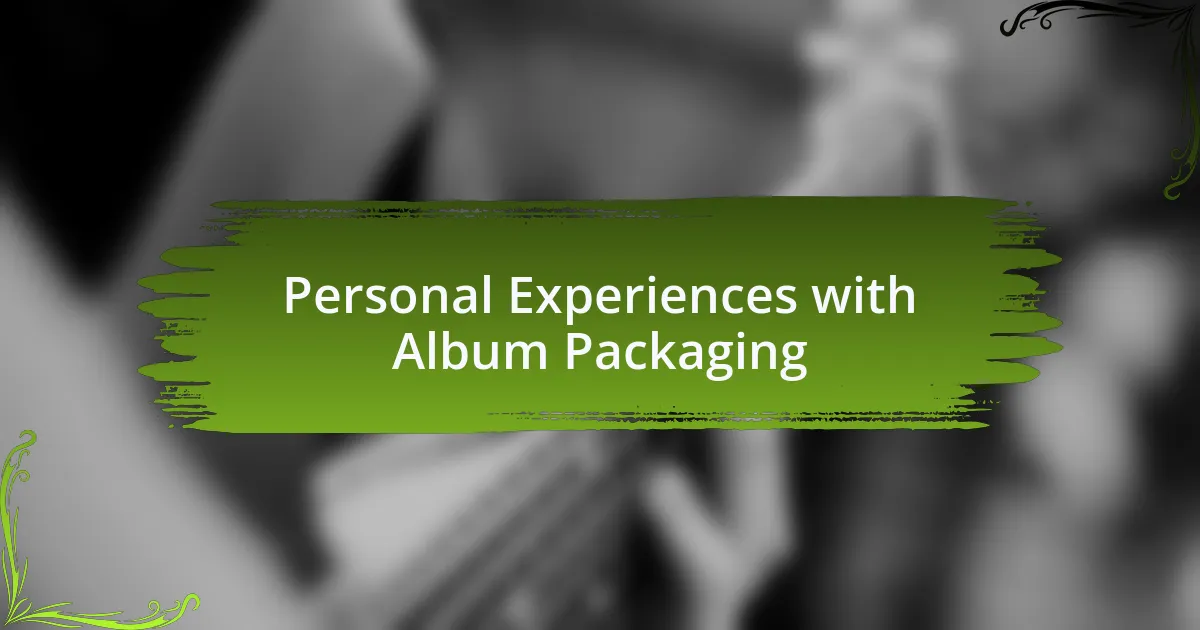
Personal Experiences with Album Packaging
When I think back to my early days as a music enthusiast, I remember the thrill of collecting CDs with intricate booklets. One album, in particular, featured a fold-out design that resembled a small art exhibition, complete with stunning visuals and personal notes from the artist. Opening that album felt like embarking on a journey, inviting me into the artist’s world. Doesn’t it make you wonder how such thoughtfully designed packaging can deepen our connection to the music itself?
I’ve also had experiences where the simplicity of album packaging spoke volumes. I recall a limited-edition release that came in a minimalist sleeve—just the artist’s name and the title in elegant typography. The absence of frills highlighted the music’s essence. It made me ponder: can less truly be more when it comes to presenting art? In this case, the packaging emphasized the purity of the sound, allowing the music to take center stage.
There was that time I stumbled upon an artist’s debut album packaged in an unexpected format—a long, narrow case that mimicked a concert ticket. The excitement of unboxing it transported me back to the live performances I cherished. It struck me that such creative representations of album packaging could evoke nostalgia and create a memorable experience beyond just listening. Isn’t it fascinating how packaging can trigger different memories and emotions, intertwining them with the sounds we cherish?

Recommendations for Album Packaging
When it comes to album packaging, I firmly believe that incorporating tactile elements is key. I remember holding a vinyl album that had a textured cover, almost like fabric. This added a physical dimension that elevated the listening experience. Have you ever noticed how the sensation of touch can ignite memories and feelings related to the music? That striking texture made me feel connected to the artist in ways that standard cardboard covers simply can’t.
Additionally, consider the importance of storytelling through visuals in album packaging. One time, I received an album with a series of striking illustrations that narrated the journey of the songs inside. Each artwork felt like a chapter in a storybook, guiding me through the emotional landscape of the music. I often find myself asking: how can a single image resonate deeper than a thousand words? In this case, the visuals created a powerful context for the sound, enriching the entire experience.
Lastly, I think sustainability should play a pivotal role in modern album packaging. I still recall unboxing an artist’s latest release, which came in biodegradable materials instead of plastic. It felt good to support ethical practices while celebrating the music I love. Could it be that environmentally friendly packaging not only reflects the values of the artist but also resonates more deeply with the audience? The answer seems clear—thoughtful packaging can have a lasting impact on our connection to the music as well as our planet.